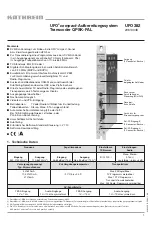
58
(1)
Protection is required to prevent dust from entering through the atmo-
spheric air inlet after installation of the manifold valve.
(2)
If process pressure range is narrow (below 10kPa (1000mmH
2
O), the
following should be considered.
• Pressure variation due to wind around atmospheric air inlet
• Temperature variation near process taps
• Difference in atmospheric pressure between process tap and
transmitter location
To overcome th is, provide atmospheric pressure-side pipe with a
proper
ori
fi
ce and consider accommodating the transmitter and
atmospheric
air inlet in a box.
5- Pressure measurement (in case of gas)
Mount the transmitter above the process pipes to pre-
venting moisture from entering the inside of transmitter.
6-
Level measurement
(1)
In case of wet leg
:
For measurement, connect the highest liquid level tapping of tank with the low pressure
side of transmitter, and the lowest liquid level tapping of tank with the high pressure side
of transmitter.
Level calculation formula
LRV
:
ρ
H
2
–
ρ
0
H
1
URV :
ρ
H
2
+
ρ
1
h –
ρ
0
H
1
Span
(
∆
P):
ρ
1
h
LRV : Low limit of measurement (0% point)
URV : High limit of measurement (100% point)
ρ
0
,
ρ
,
ρ
1
: Density
H
1
, H
2
: Liquid level, h: Liquid level change
(2) In case of dry leg:
For an open tank, leave the low pressure side of transmitter open to atmosphere.
Level calculation formula
LRV:
ρ
H
1
URV:
ρ
H
1
+
ρ
1
h
Span (DP):
ρ
1
h
LRV: Low limit of measurement (0% point)
URV: High limit of measurement (100% point)
ρ
,
ρ
1
: Density
H
1
: Liquid level, h: Liquid level change
H
1
H
2
Max. liquid level
Min. liquid level
Condensor
R
0
R
Manifold
valve
h
1
R
High pressure
side
Low pressure
side
Stop valve
Process pipe
Pressure source
Impulse pipe
Manifold valve
Atmospheric
air inlet
H
1
Max. liquid level
Min. liquid level
R
Manifold
valve
Atomospheric
air inlet
h
R
1
Low pressure
side
High pressure side
ATTENTION
















































